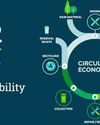Interview With Mr. Pradeep David
June 2017
|Textile Value Chain
General Manager, Universal Robots, India And Sri Lanka
-

1. Give us a brief background of Universal Robots.
In 2003, the three founders of the company, Esben Østergaard, Kasper Støy and Kristian Kassow, together came up with the idea of creating a light robot that is easy to install and program as they could see that heavy, expensive and unwieldy robots were dominating robotics and there was a huge market for a user-friendly option. In 2005, they officially founded Universal Robots, with the aim of making robot technology accessible to small and medium-sized enterprises. An investment by Syddansk Innovation shaped the foundation of the company.
In 2008, the company sold its first product through distributers in Denmark and Germany. Universal Robots’ first product was the UR5, a six jointed articulated robotic arm that revolutionized the market for industrial robots. The UR5 weighs 18 kg, has a lifting capacity of up to 5 kg and a working radius of 85 cm. Within a year the company expanded its business in the entire European markets.
In 2011, Universal Robots entered the Asian market with an office in China and in next two years, they established subsidiaries, in New York, Shanghai and, also established a distributor network in South America and Oceania.
The second product UR 10 was also launched at the same time. It was targeted towards larger tasks with a lifting ability of 10 kg and a reach of 130 cm. In 2015, the company witnessed the launch of world’s most flexible, lightweight table-top robot UR3, to work alongside humans, which has a payload capacity of 3 kilos which can be used for light assembly tasks and automated workbench scenarios.
The company is a part of Teradyne Inc., headquartered in Odense, Denmark. UR has subsidiaries and regional offices in the USA, Spain, Germany, Italy, Czech Republic, China, Singapore, India, Japan, Taiwan and South Korea.
هذه القصة من طبعة June 2017 من Textile Value Chain.
اشترك في Magzter GOLD للوصول إلى آلاف القصص المتميزة المنسقة، وأكثر من 9000 مجلة وصحيفة.
هل أنت مشترك بالفعل؟ تسجيل الدخول
المزيد من القصص من Textile Value Chain

Textile Value Chain
EPR in Textiles: Turning Compliance into Opportunity
When the EU Comes to Panipat, It Means One Thing — The World Is Watching
3 mins
November 2025

Textile Value Chain
European Parliament Delegation Visits Panipat Recycling Cluster to Strengthen India-EU Collaboration on Circular Textiles
A high-level delegation from the European Parliament's Committee on International Trade (INTA) visited the Panipat Textile Recycling Cluster — India's largest hub for recycled textiles and circular manufacturing — during their official visit to India.
1 mins
November 2025

Textile Value Chain
Paramount Instruments: Where Innovation Turns Testing into Joy
At Paramount Instruments, innovation isn't just a Pursuit- it's in our DNA.
2 mins
November 2025
Textile Value Chain
Crafting the Future: LMW & Hami Weavelon pioneer Compact Spinning in Polyester
Manmade fibres today form the backbone of the global textile industry, driven by their versatility, performance, and ability to meet the rising demand for both everyday and specialised applications.
3 mins
November 2025

Textile Value Chain
Data is the New Thread: Weaving India's Textile Sector into a Circular Powerhouse
On November 13, 2025, at the 12th Edition of the India and Sustainability Standards (ISS) International Dialogue and Conference held at Bharat Mandapam in New Delhi, representatives from the Home Exporters Welfare Association of India (HEWA) joined industry leaders, policymakers, and international organizations to address a pressing question: How can India's textile sector meet emerging global data requirements while supporting its MSME backbone?
3 mins
November 2025

Textile Value Chain
Rieter Winding Suction Nozzle Upgrade: More Yarn, Less Energy Use
After upgrading the suction nozzles on their 32 winding machines, Sanyang Textile Co., Ltd., China, saw an increase in yarn production of 3% and a reduction of 13% in energy use. The flow-optimised, aerodynamically designed suction nozzle enables efficient upper yarn search and pickup from the package. This results in a 55% reduction in red light percentage and a significant reduction in the operator's workload.
1 mins
November 2025

Textile Value Chain
EU's Extended Producer Responsibility (EPR) Law and Its Implications for India's Textile Industry
The European Union (EU) has approved a new Extended Producer Responsibility (EPR) framework for textiles. This is a major regulatory shift that makes fashion brands and producers accountable for their products' entire lifecycle, from design and production through collection, sorting, recycling and disposal.
9 mins
November 2025

Textile Value Chain
GTE Ahmedabad 2025 Concludes Day 3 with a Huge Footfall
The 38th Garment Technology Expo (GTE) Ahmedabad 2025, co-located with the Lace & Trims Show, wrapped up its third day on an impressive note, recording around 9,700 B2B visitors. The strong industry turnout reaffirmed the expo's role as one of the most influential and business-driven platforms for garment and apparel technology in the western region.
2 mins
November 2025

Textile Value Chain
Reinterpreting Korean Street Fashion through Sustainable Design Practices
A Path through Eco-conscious Urban Fashion
7 mins
November 2025

Textile Value Chain
3D Printing in Textiles Manufacturing: A Game-Changer in Design, Sustainability, and Efficiency
The global textile and apparel industry is undergoing a radical transformation due to the convergence of digital design, advanced material technology, and next-generation manufacturing. Of the latter, few have greater potential to change how textiles are made today than additive manufacturing, better known as 3D printing.
5 mins
November 2025
Translate
Change font size

